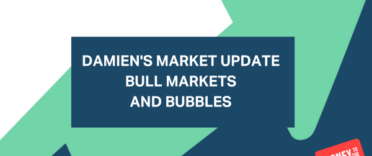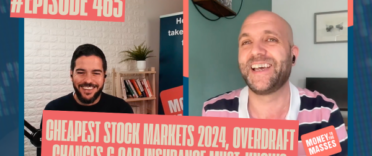The 144th episode of my weekly YouTube show where I discuss what is happening in investment markets and what to look out for. This week I explain the factors that are causing wild movements in the markets
Each show lasts between 5-10 minutes and is aimed at DIY investors (including novices) seeking contemporary analysis to help them understand how investment markets work.
Subscribe to my YouTube channel to receive my weekly analysis of investment markets or alternatively, you can listen via my weekly Midweek Markets podcast below.
Midweek Markets weekly podcast
Other ways to watch, listen and subscribe
You can listen to other episodes and subscribe to the show by searching 'Money to the Masses' on Spotify or by using the following links:
Abridged transcript - Midweek Markets episode 144
Some weeks when I do this show it can feel like not much has happened since the previous episode. You can get periods where the market movements and associated narratives become fairly rigid. But then you get weeks like this week where I almost don’t know where to start. There’s almost too much to cover in a 10-minute show, but not only that, things are moving at such a pace that any insights that I provide are almost immediately rendered tomorrow’s chip paper.
But that is part of the fun of following investment markets. So as a quick reminder of where markets were this time last week, the German DAX (and European equities more generally) had surged from recent lows in a rally inspired by hope for monetary and fiscal stimulus in the eurozone as well as a de-escalation of the war in Ukraine. Bonds continued to behave like risk assets with the yield on the 10 year US treasury jumping to 1.955%. Gold was surging and hit a new high of $2078 an ounce. Meanwhile, commodities had just enjoyed their sharpest weekly rally in 50 years while the price of a barrel of Brent Crude touched $139. In fact the title of last week’s show was “History in the making”.
But in fairness that could well have been the title for this week’s show too. First of all, let’s start in Asia and in particular in China. Chinese equities have been in the grip of a sell-off that sparked memories of the financial crisis in 2008. In fact on Monday this week, the Hang Seng China Enterprises Index of mainland Chinese stocks fell over 7% - the most since the financial crisis - to only then fall another 5% on Tuesday. This brought the year to date losses to -25%. Chinese tech stocks fared even worse, with Alibaba share price, for example, down 38% for the year, up to and including Wednesday. Traders were nursing huge losses with no respite in sight.
The cause of the carnage was a combination of factors. Continued stress in the Chinese property market, an ongoing regulatory crackdown on Chinese tech companies, the threat of sanctions by the US as punishment for China’s support of Russia’s invasion of Ukraine, plus rising Covid cases. The latter even caused Chinese authorities to announce a six-day lockdown in Shenzhen, impacting over 17 million people, with further lockdowns across China possible. With no glimmer of hope on the horizon for investors, the Chinese authorities stepped in to reassure them by promising economic stimulus as well as measures to help support the market. If you thought last week’s moves on the DAX were crazy, they have nothing on what we witnessed in Chinese equity markets following the announcement.
The Hang Seng tech index leapt 22%, its best day since October 2008. All these comparisons to the financial crisis, are a little disconcerting even when they are positive. The share price of Alibaba leapt 27.3%. These are mind-boggling moves yet we still await full details of what the promised interventions are. The authorities are obviously still making them up.
While talking of interventions it seems a natural segue into talking about central banks’ policy decisions. First up was the European Central Bank (ECB) which announced its latest decision just after last week’s show. The ECB ultimately surprised the market by announcing it was bringing forward its plans to curtail the monetary stimulus measures it has had in place since the pandemic, reducing its bond-buying scheme from April through to June, with the possibility that it may stop adding to its bond portfolio by the third quarter of this year. This could mean it is more likely to increase interest rates by the end of the year as the ECB desperately tries to keep a lid on inflation. To be clear, this was a more hawkish announcement than expected from the ECB, which has traditionally been one of the most dovish of the major global central banks. Bond and equity markets in Europe recoiled from the news, albeit temporarily.
If you judge the European market response by looking at the German DAX, despite the hawkish ECB, it is now up 13% from its recent low, which pares its year to date loss to 11%. But a significant tailwind has been the crash in commodity prices we’ve seen in the last week. The price of oil tumbled back below $100 barrel, a fall of almost 30% as traders hoped for an improved supply outlook following positive statements around Ukrainian and Russian peace talks. But in addition, the potential for a Covid-19 induced shutdown of the Chinese economy sparked fears of a drop in commodity demand. As commodity prices fell, equity markets rallied. The price of Gold plummeted over 7%, back towards $1900 per ounce, while energy stocks lagged the wider market. Energy stocks, commodities and gold had risen so far so fast, especially after the invasion of Ukraine, that they had almost become the consensus trade, so some form of pullback was inevitable.
In the last 24 hours we’ve seen the US Federal Reserve (the Fed) and the Bank of England both raise interest rates by 0.25%. The Fed even went as far as acknowledging that a further 6 to 7 interest rate hikes are likely this year, matching what the market had started to price in. This was a hawkish statement, yet after Fed Chair Jerome Powell painted a positive picture of a booming US economy that can withstand such monetary tightening, US stocks rallied. This is despite the economic uncertainty caused by rising energy and commodity prices following the invasion of Ukraine. Even the Bank warned inflation, might hit 8% in the coming months. You may have thought that equity markets might have taken at least a breather in light of the Fed’s decision. But no.
Interestingly, last week I discussed the positive technical signs we were seeing in the S&P 500, and they continue to be present giving hope to the fact that a short term bottom in equity markets may now be in, excepting any further escalation in Ukraine. Certainly, risk assets are enjoying a rebound, but there’s still a lot to be done technically to safely consign this correction to history.
While narratives continue to change by the hour, one consistent theme has been for higher bond yields. The 10 year US treasury yield hit 2.2% in the aftermath of the Fed’s policy decision. In fact, the bond market is now sending out a different message than equity markets. While it seems to be agreed on the fact that inflation is going to lead to higher interest rates, it is also starting to suggest that the Fed’s policy tightening is likely to be a mistake and lead to a US recession - and when the US sneezes the world catches a cold. You can tell this recessionary hint through the early signs of yield inversion on US treasuries, something I have spoken about in the past. Ironically the bond market is even hinting that the Fed will be forced to cut rates again in the future to support the economy. Maybe this is what equity markets are looking at, that bad news (rate hikes) is actually good news (future rate cuts). It sounds odd, but this is what equity investors have been doing for much of the post-financial crisis era.
Ultimately right now, there is a sense that investors, analysts and central bankers are making it all up as they go along.




